cruise control SAAB 9-3 2009 Owners Manual
[x] Cancel search | Manufacturer: SAAB, Model Year: 2009, Model line: 9-3, Model: SAAB 9-3 2009Pages: 304, PDF Size: 44.31 MB
Page 3 of 304
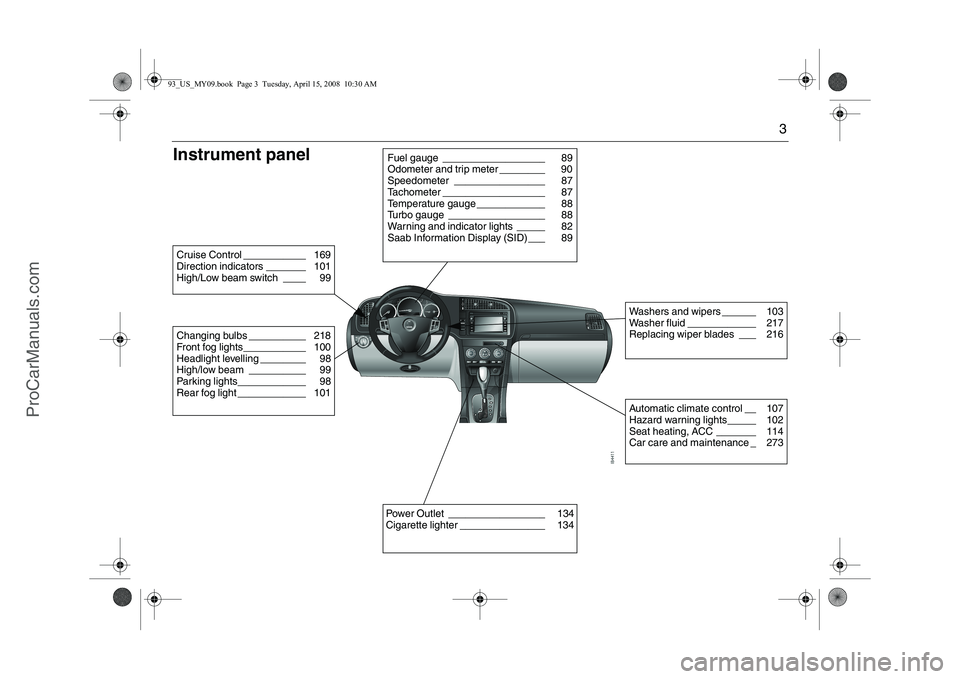
3
Instrument panelChanging bulbs __________ 218
Front fog lights___________ 100
Headlight levelling ________ 98
High/low beam __________ 99
Parking lights____________ 98
Rear fog light ____________ 101Cruise Control ___________ 169
Direction indicators _______ 101
High/Low beam switch ____ 99
Fuel gauge __________________ 89
Odometer and trip meter ________ 90
Speedometer ________________ 87
Tachometer __________________ 87
Temperature gauge ____________ 88
Turbo gauge _________________ 88
Warning and indicator lights _____ 82
Saab Information Display (SID) ___ 89Power Outlet _________________ 134
Cigarette lighter _______________ 134
Washers and wipers ______ 103
Washer fluid ____________ 217
Replacing wiper blades ___ 216Automatic climate control __ 107
Hazard warning lights_____ 102
Seat heating, ACC _______ 114
Car care and maintenance _ 273
93_US_MY09.book Page 3 Tuesday, April 15, 2008 10:30 AM
ProCarManuals.com
Page 86 of 304

86 Instruments and controlsThis light comes on when there is less than
about 2.5 gallons (10 liter) of fuel left in the
tank.
This light indicates that the headlights or
parking lights are on.
This light comes on when the system is
engaged.This symbol lights up when the system is
operative.
Operation of the ESP
® indicates reduced
cohesion between the tires and the road,
and that extra care should be taken by the
driver.This symbol lights up when the system is
disengaged, see page 176.
If there is a malfunction, the symbol cannot
be turned off by pressing the ESP
® button.
The following message is shown on the
Saab Information Display (SID):
If so, have the system checked at a Saab
dealer.
See also Electronic Stability Program ESP
®
on page 175.
Indicator, fuel
NOTICE
If the car runs out of fuel, air can be drawn
in with the fuel, which, in turn, can cause
the catalytic converter to be damaged by
overheating.
Headlight and parking
light indicator
Cruise control indicator
light
ESP
® indicator
ESP® OFF indicatorWARNING
The system improves stability and
maneuverability under slippery road and
extreme driving conditions. It must how-
ever not be regarded as a system
to enable the driver to maintain higher
speeds. The same precautions as
normal for safe cornering and driving
on slippery roads must be adopted (see
pages 173/ 175).
Stability control failure.
Contact service.
93_US_MY09.book Page 86 Tuesday, April 15, 2008 10:30 AM
ProCarManuals.com
Page 149 of 304

149 Starting and driving
Ignition switch ________ 150
Steering wheel lock ____ 151
Starting the engine ____ 152
Important considerations
for driving __________ 153
Refueling ____________ 156
Engine Break-in Period _ 160
Manual transmission___ 161
Automatic
transmission3______ 162
Cruise Control ________ 169
Braking ______________ 170
All-wheel drive (XWD)3173
Traction Control System
(TCS) ______________ 173
Electronic Stability
Program ESP
®
______ 175
Parking brake_________ 177 Parking _______________ 177
Saab Parking
Assistance3________ 180
Economical driving _____ 183
Driving in cold weather__ 185
Driving in hot climates __ 187
Towing a trailer3______ 188
Driving with a roof rack
load ________________ 192
Driving with a load _____ 192
Driving with the trunk lid
open________________ 193
Driving in deep water ___ 193
Towing the car _________ 193
Jump starting _________ 197
For long trips __________ 199
Starting and driving
3Asterisk means: equipment not fitted in all cars
(can depend on model variant, engine variant,
market specification, options or accessories).93_US_MY09.book Page 149 Tuesday, April 15, 2008 10:30 AM
ProCarManuals.com
Page 154 of 304
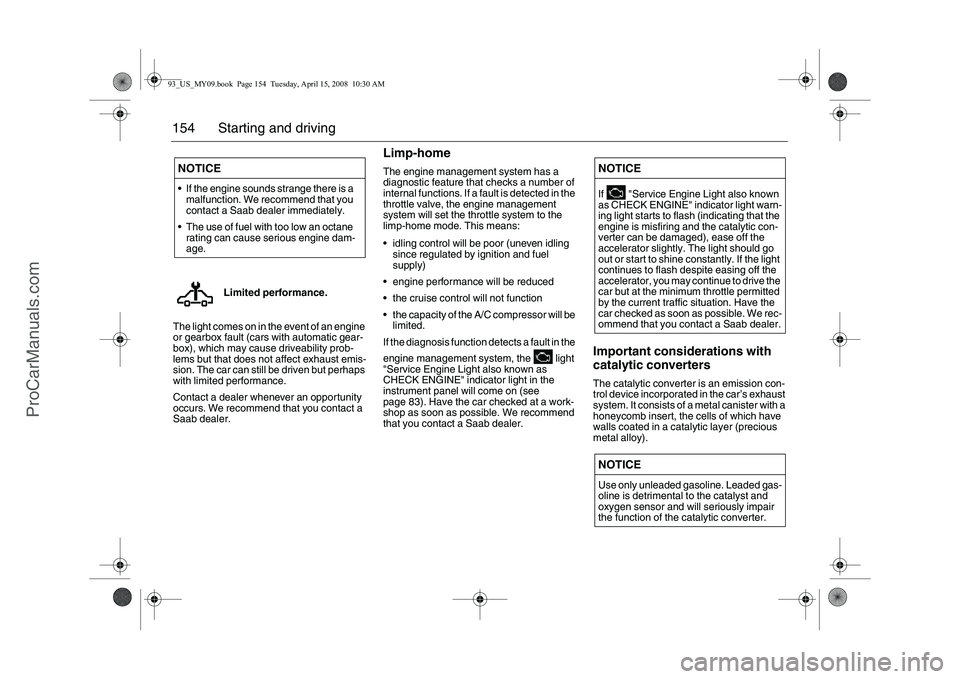
154 Starting and drivingThe light comes on in the event of an engine
or gearbox fault (cars with automatic gear-
box), which may cause driveability prob-
lems but that does not affect exhaust emis-
sion. The car can still be driven but perhaps
with limited performance.
Contact a dealer whenever an opportunity
occurs. We recommend that you contact a
Saab dealer.
Limp-homeThe engine management system has a
diagnostic feature that checks a number of
internal functions. If a fault is detected in the
throttle valve, the engine management
system will set the throttle system to the
limp-home mode. This means:
idling control will be poor (uneven idling
since regulated by ignition and fuel
supply)
engine performance will be reduced
the cruise control will not function
the capacity of the A/C compressor will be
limited.
If the diagnosis function detects a fault in the
engine management system, the light
"Service Engine Light also known as
CHECK ENGINE" indicator light in the
instrument panel will come on (see
page 83). Have the car checked at a work-
shop as soon as possible. We recommend
that you contact a Saab dealer.
Important considerations with
catalytic convertersThe catalytic converter is an emission con-
trol device incorporated in the car’s exhaust
system. It consists of a metal canister with a
honeycomb insert, the cells of which have
walls coated in a catalytic layer (precious
metal alloy).
NOTICE If the engine sounds strange there is a
malfunction. We recommend that you
contact a Saab dealer immediately.
The use of fuel with too low an octane
rating can cause serious engine dam-
age.
Limited performance.
NOTICEIf "Service Engine Light also known
as CHECK ENGINE" indicator light warn-
ing light starts to flash (indicating that the
engine is misfiring and the catalytic con-
verter can be damaged), ease off the
accelerator slightly. The light should go
out or start to shine constantly. If the light
continues to flash despite easing off the
accelerator, you may continue to drive the
car but at the minimum throttle permitted
by the current traffic situation. Have the
car checked as soon as possible. We rec-
ommend that you contact a Saab dealer.NOTICEUse only unleaded gasoline. Leaded gas-
oline is detrimental to the catalyst and
oxygen sensor and will seriously impair
the function of the catalytic converter.
93_US_MY09.book Page 154 Tuesday, April 15, 2008 10:30 AM
ProCarManuals.com
Page 169 of 304

169 Starting and driving
Cruise Control(Cruise control system)
For safety reasons (brake system func-
tion), the brakes must be applied once
when the engine has started, before the
cruise control system can be activated.
The following message is shown on the SID:
The system has the following functions:
1 ON: engaged
2 OFF: disengaged
3 SET/+: sets the speed and increases
the set speed
4 SET/ –: sets the speed and decreases
the set speed
5 RESUME: re-engages the system at the
set speed
The CRUISE indicator light in the main
instrument panel comes on when the switch
is slid to ON. If you switch off the engine
while the cruise control is ON, the system
will be ON the next time the engine is
started.
To set the desired speed1 Slide the switch to ON.
2 Move the thumb wheel up to SET/+ or
SET/– when the car has reached the
desired speed (above 15 mph
(25 km/h).To increase the preset speedYou can increase the speed in any of
the following ways:
Accelerate to the desired speed. Jog the
control to SET/+ or SET/–.
Jog the control to SET/+ to increase the
speed by 1 mph (1.6 km/h) (when cruise
control already engaged).
Hold the control in the SET/+ position until
the desired speed is reached (when
cruise control already engaged).
WARNING
Do not use the cruise control system in
wet or icy conditions, in dense traffic or on
winding roads.
Tap brakes lightly
before using cruise ctrl.
Cruise control switches
93_US_MY09.book Page 169 Tuesday, April 15, 2008 10:30 AM
ProCarManuals.com
Page 170 of 304
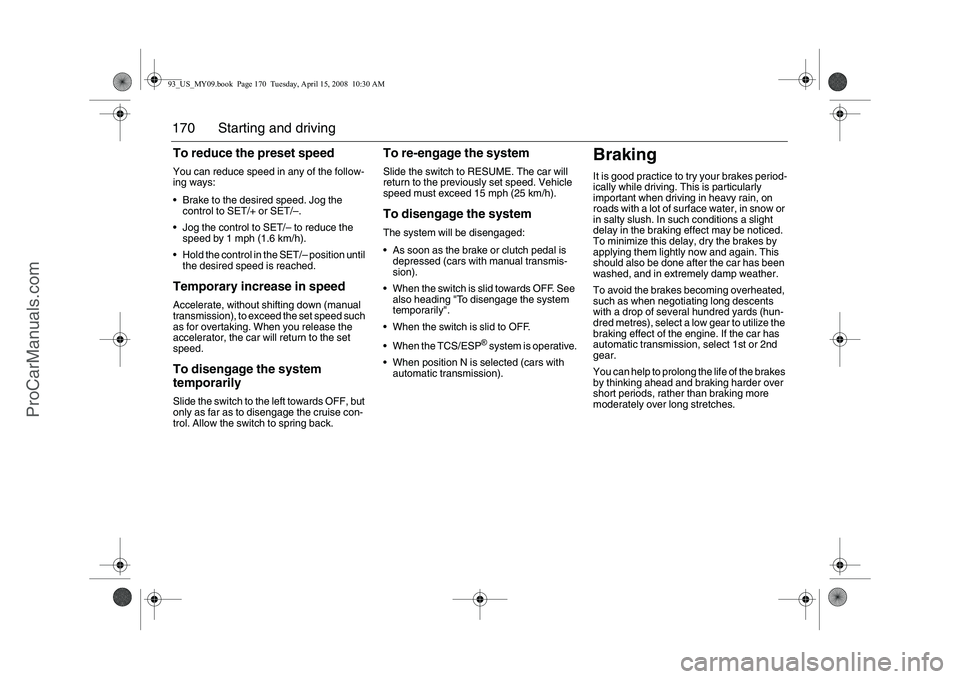
170 Starting and drivingTo reduce the preset speedYou can reduce speed in any of the follow-
ing ways:
Brake to the desired speed. Jog the
control to SET/+ or SET/–.
Jog the control to SET/– to reduce the
speed by 1 mph (1.6 km/h).
Hold the control in the SET/– position until
the desired speed is reached.Temporary increase in speedAccelerate, without shifting down (manual
transmission), to exceed the set speed such
as for overtaking. When you release the
accelerator, the car will return to the set
speed.To disengage the system
temporarilySlide the switch to the left towards OFF, but
only as far as to disengage the cruise con-
trol. Allow the switch to spring back.
To re-engage the systemSlide the switch to RESUME. The car will
return to the previously set speed. Vehicle
speed must exceed 15 mph (25 km/h).To disengage the systemThe system will be disengaged:
As soon as the brake or clutch pedal is
depressed (cars with manual transmis-
sion).
When the switch is slid towards OFF. See
also heading "To disengage the system
temporarily".
When the switch is slid to OFF.
When the TCS/ESP
® system is operative.
When position N is selected (cars with
automatic transmission).
BrakingIt is good practice to try your brakes period-
ically while driving. This is particularly
important when driving in heavy rain, on
roads with a lot of surface water, in snow or
in salty slush. In such conditions a slight
delay in the braking effect may be noticed.
To minimize this delay, dry the brakes by
applying them lightly now and again. This
should also be done after the car has been
washed, and in extremely damp weather.
To avoid the brakes becoming overheated,
such as when negotiating long descents
with a drop of several hundred yards (hun-
dred metres), select a low gear to utilize the
braking effect of the engine. If the car has
automatic transmission, select 1st or 2nd
gear.
You can help to prolong the life of the brakes
by thinking ahead and braking harder over
short periods, rather than braking more
moderately over long stretches.
93_US_MY09.book Page 170 Tuesday, April 15, 2008 10:30 AM
ProCarManuals.com
Page 174 of 304
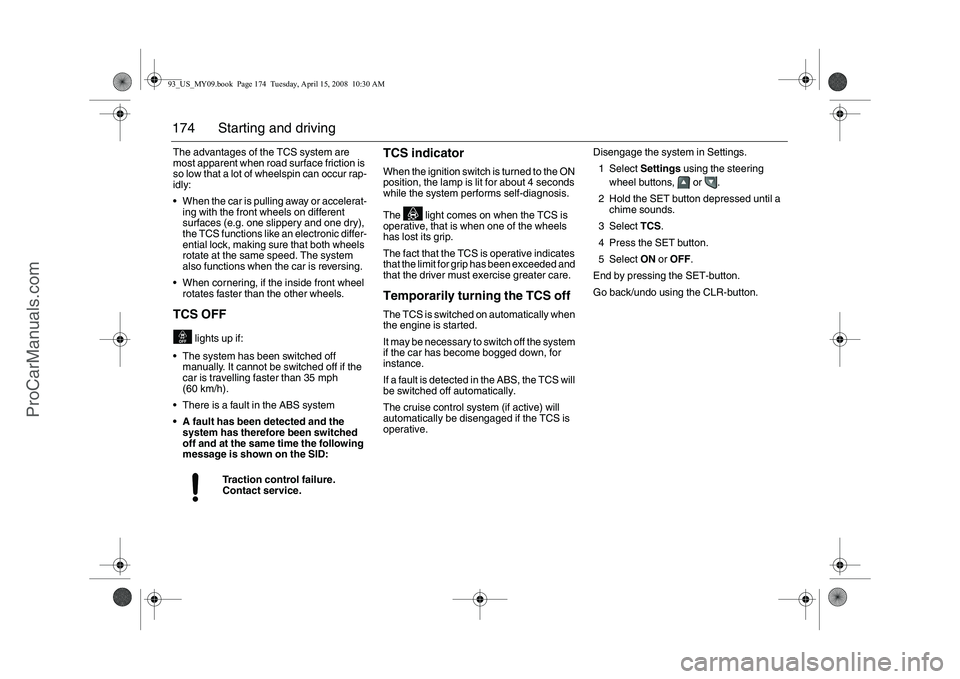
174 Starting and drivingThe advantages of the TCS system are
most apparent when road surface friction is
so low that a lot of wheelspin can occur rap-
idly:
When the car is pulling away or accelerat-
ing with the front wheels on different
surfaces (e.g. one slippery and one dry),
the TCS functions like an electronic differ-
ential lock, making sure that both wheels
rotate at the same speed. The system
also functions when the car is reversing.
When cornering, if the inside front wheel
rotates faster than the other wheels.TCS OFF
lights up if:
The system has been switched off
manually. It cannot be switched off if the
car is travelling faster than 35 mph
(60 km/h).
There is a fault in the ABS system
A fault has been detected and the
system has therefore been switched
off and at the same time the following
message is shown on the SID:
TCS indicatorWhen the ignition switch is turned to the ON
position, the lamp is lit for about 4 seconds
while the system performs self-diagnosis.
The light comes on when the TCS is
operative, that is when one of the wheels
has lost its grip.
The fact that the TCS is operative indicates
that the limit for grip has been exceeded and
that the driver must exercise greater care.Temporarily turning the TCS offThe TCS is switched on automatically when
the engine is started.
It may be necessary to switch off the system
if the car has become bogged down, for
instance.
If a fault is detected in the ABS, the TCS will
be switched off automatically.
The cruise control system (if active) will
automatically be disengaged if the TCS is
operative.Disengage the system in Settings.
1Select Settings using the steering
wheel buttons, or .
2 Hold the SET button depressed until a
chime sounds.
3Select TCS.
4 Press the SET button.
5Select ON or OFF.
End by pressing the SET-button.
Go back/undo using the CLR-button.
Traction control failure.
Contact service.
93_US_MY09.book Page 174 Tuesday, April 15, 2008 10:30 AM
ProCarManuals.com
Page 176 of 304
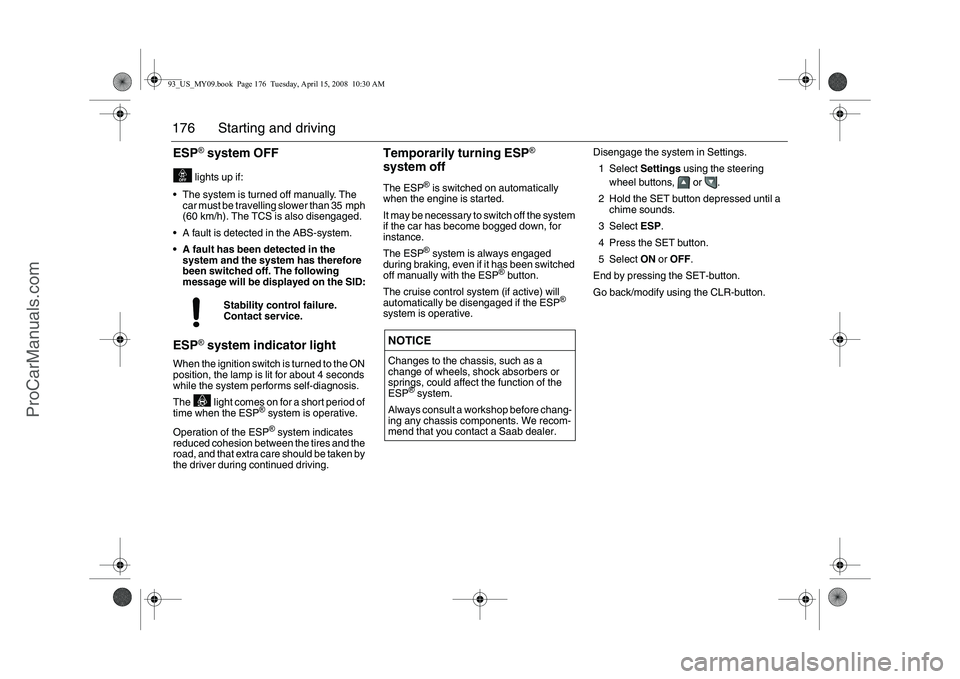
176 Starting and drivingESP
® system OFF
lights up if:
The system is turned off manually. The
car must be travelling slower than 35 mph
(60 km/h). The TCS is also disengaged.
A fault is detected in the ABS-system.
A fault has been detected in the
system and the system has therefore
been switched off. The following
message will be displayed on the SID:
ESP
® system indicator light
When the ignition switch is turned to the ON
position, the lamp is lit for about 4 seconds
while the system performs self-diagnosis.
The light comes on for a short period of
time when the ESP
® system is operative.
Operation of the ESP® system indicates
reduced cohesion between the tires and the
road, and that extra care should be taken by
the driver during continued driving.
Temporarily turning ESP
®
system off
The ESP
® is switched on automatically
when the engine is started.
It may be necessary to switch off the system
if the car has become bogged down, for
instance.
The ESP® system is always engaged
during braking, even if it has been switched
off manually with the ESP
® button.
The cruise control system (if active) will
automatically be disengaged if the ESP
®
system is operative.Disengage the system in Settings.
1Select Settings using the steering
wheel buttons, or .
2 Hold the SET button depressed until a
chime sounds.
3Select ESP.
4 Press the SET button.
5Select ON or OFF.
End by pressing the SET-button.
Go back/modify using the CLR-button.
Stability control failure.
Contact service.
NOTICEChanges to the chassis, such as a
change of wheels, shock absorbers or
springs, could affect the function of the
ESP
® system.
Always consult a workshop before chang-
ing any chassis components. We recom-
mend that you contact a Saab dealer.
93_US_MY09.book Page 176 Tuesday, April 15, 2008 10:30 AM
ProCarManuals.com
Page 294 of 304
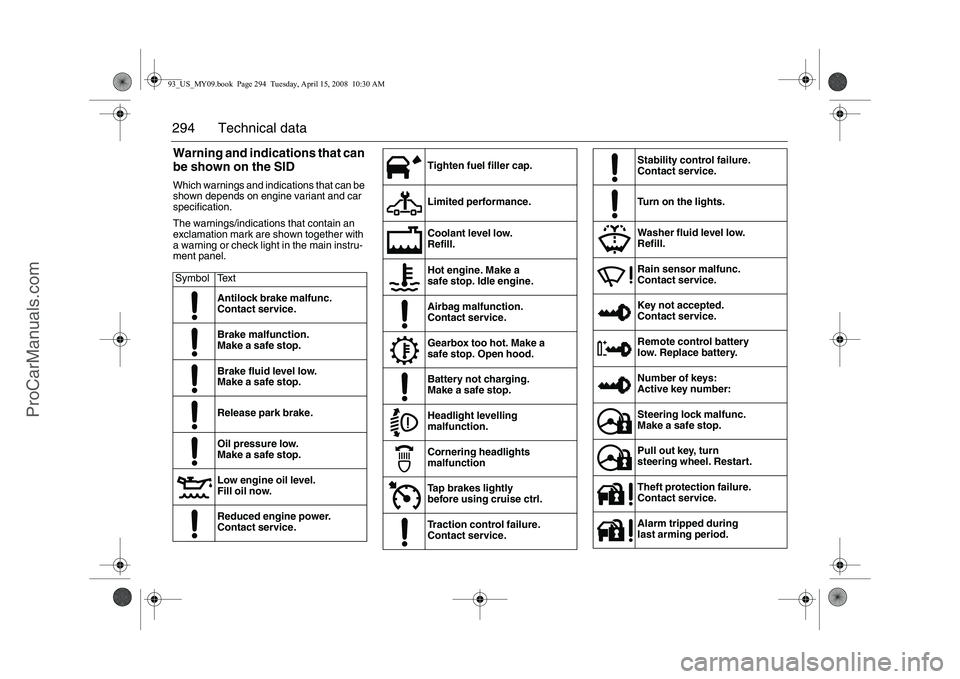
294 Technical dataWarning and indications that can
be shown on the SIDWhich warnings and indications that can be
shown depends on engine variant and car
specification.
The warnings/indications that contain an
exclamation mark are shown together with
a warning or check light in the main instru-
ment panel.
Symbol Text
Antilock brake malfunc.
Contact service.
Brake malfunction.
Make a safe stop.
Brake fluid level low.
Make a safe stop.
Release park brake.
Oil pressure low.
Make a safe stop.
Low engine oil level.
Fill oil now.
Reduced engine power.
Contact service.
Tighten fuel filler cap.
Limited performance.
Coolant level low.
Refill.
Hot engine. Make a
safe stop. Idle engine.
Airbag malfunction.
Contact service.
Gearbox too hot. Make a
safe stop. Open hood.
Battery not charging.
Make a safe stop.
Headlight levelling
malfunction.
Cornering headlights
malfunction
Tap brakes lightly
before using cruise ctrl.
Traction control failure.
Contact service.
Stability control failure.
Contact service.
Turn on the lights.
Washer fluid level low.
Refill.
Rain sensor malfunc.
Contact service.
Key not accepted.
Contact service.
Remote control battery
low. Replace battery.
Number of keys:
Active key number:
Steering lock malfunc.
Make a safe stop.
Pull out key, turn
steering wheel. Restart.
Theft protection failure.
Contact service.
Alarm tripped during
last arming period.
93_US_MY09.book Page 294 Tuesday, April 15, 2008 10:30 AM
ProCarManuals.com
Page 297 of 304
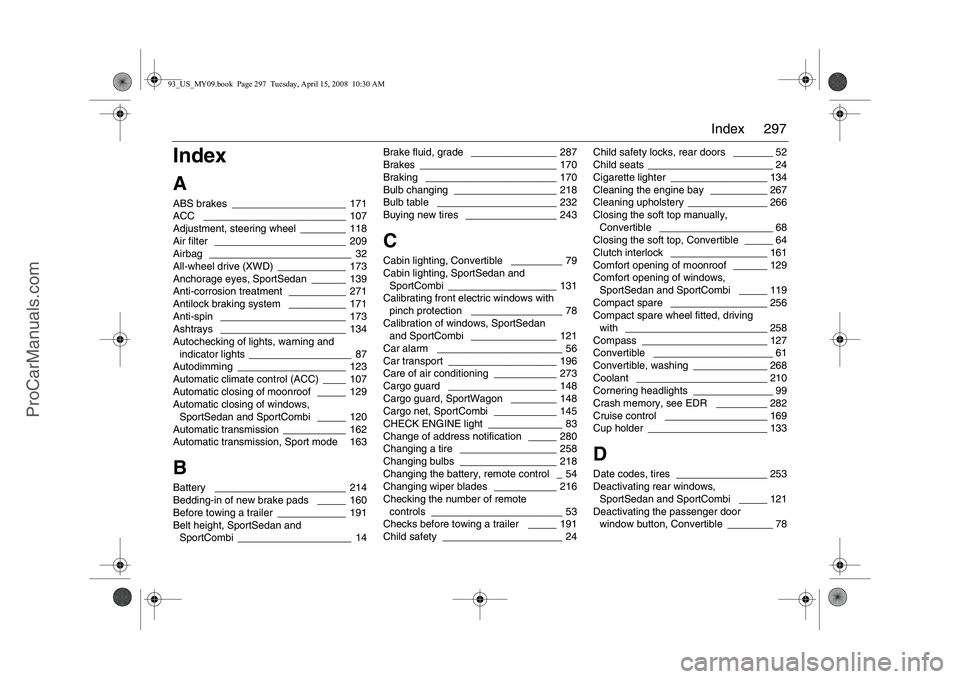
297 Index
IndexAABS brakes
____________________ 171
ACC
_________________________ 107
Adjustment, steering wheel
________ 118
Air filter
_______________________ 209
Airbag
_________________________ 32
All-wheel drive (XWD)
____________ 173
Anchorage eyes, SportSedan
______ 139
Anti-corrosion treatment
__________ 271
Antilock braking system __________ 171
Anti-spin
______________________ 173
Ashtrays ______________________ 134
Autochecking of lights, warning and
indicator lights
__________________ 87
Autodimming
___________________ 123
Automatic climate control (ACC)
____ 107
Automatic closing of moonroof
_____ 129
Automatic closing of windows,
SportSedan and SportCombi _____ 120
Automatic transmission
___________ 162
Automatic transmission, Sport mode
163
BBattery
_______________________ 214
Bedding-in of new brake pads
_____ 160
Before towing a trailer
____________ 191
Belt height, SportSedan and
SportCombi
____________________ 14Brake fluid, grade
_______________ 287
Brakes
________________________ 170
Braking _______________________ 170
Bulb changing
__________________ 218
Bulb table
_____________________ 232
Buying new tires
________________ 243
CCabin lighting, Convertible
_________ 79
Cabin lighting, SportSedan and
SportCombi
___________________ 131
Calibrating front electric windows with
pinch protection
________________ 78
Calibration of windows, SportSedan
and SportCombi _______________ 121
Car alarm
______________________ 56
Car transport ___________________ 196
Care of air conditioning
___________ 273
Cargo guard
___________________ 148
Cargo guard, SportWagon
________ 148
Cargo net, SportCombi
___________ 145
CHECK ENGINE light _____________ 83
Change of address notification
_____ 280
Changing a tire
_________________ 258
Changing bulbs _________________ 218
Changing the battery, remote control
_54
Changing wiper blades
___________ 216
Checking the number of remote
controls
_______________________ 53
Checks before towing a trailer
_____ 191
Child safety
_____________________ 24Child safety locks, rear doors
_______ 52
Child seats
______________________ 24
Cigarette lighter
_________________ 134
Cleaning the engine bay
__________ 267
Cleaning upholstery
______________ 266
Closing the soft top manually,
Convertible
____________________ 68
Closing the soft top, Convertible
_____ 64
Clutch interlock
_________________ 161
Comfort opening of moonroof
______ 129
Comfort opening of windows,
SportSedan and SportCombi _____ 119
Compact spare
_________________ 256
Compact spare wheel fitted, driving
with
_________________________ 258
Compass
______________________ 127
Convertible _____________________ 61
Convertible, washing
_____________ 268
Coolant
_______________________ 210
Cornering headlights
______________ 99
Crash memory, see EDR
_________ 282
Cruise control
__________________ 169
Cup holder
_____________________ 133
DDate codes, tires
________________ 253
Deactivating rear windows,
SportSedan and SportCombi
_____ 121
Deactivating the passenger door
window button, Convertible
________ 78
93_US_MY09.book Page 297 Tuesday, April 15, 2008 10:30 AM
ProCarManuals.com